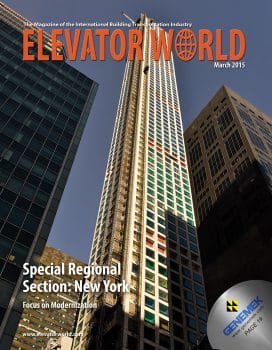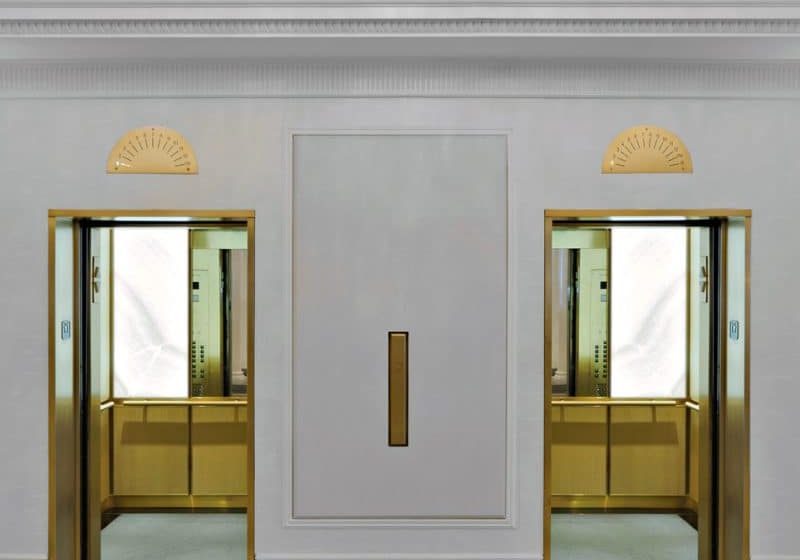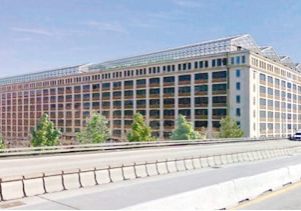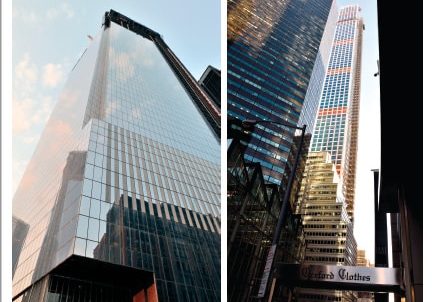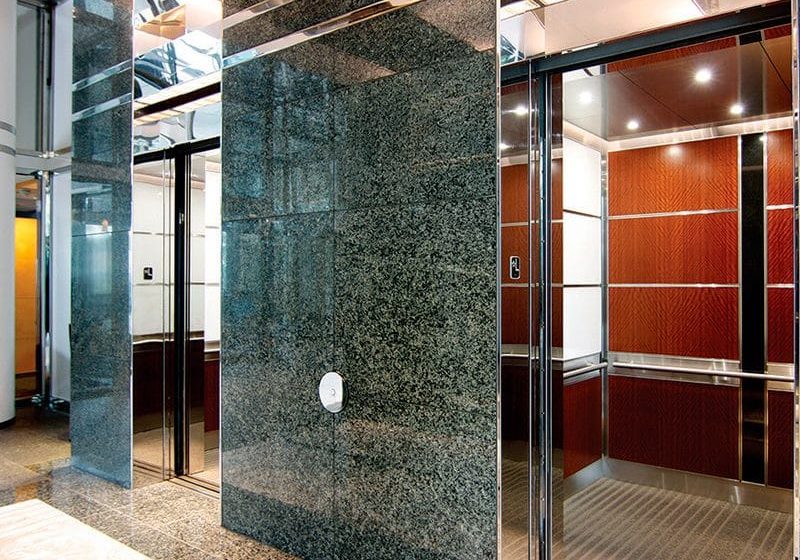Ride the Pink Elevator
Mar 1, 2015
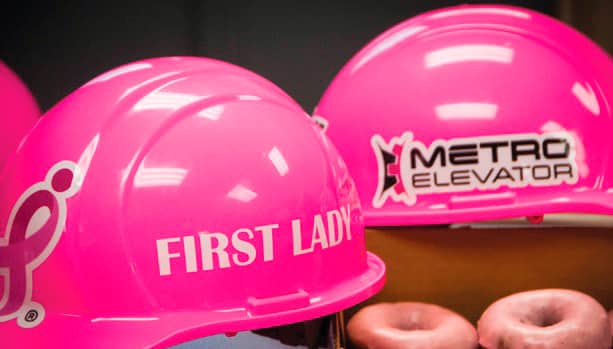
Metro Elevator partners with Susan G. Komen to help find a cure for breast cancer.
It was an innocent enough idea at the time. “I wonder what would happen if we painted them pink and turned them into goodwill ambassadors,” Metro Elevator’s executive vice president, Roger Brummett, thought out loud as he watched Metro’s paint professional, Dave Picco, spraypaint one of Metro’s 6000-lb.-capacity construction hoists. Brummett was trying to conceive of a way to further build brand recognition and help the 44-year-old company do something unique that would differentiate it from other providers of hoisting and lifting services nationwide. The company had earned a positive reputation as a regional player, supplying construction and material hoists for major construction projects; but, there was this sense that the time was right to expand its marketing reach across the continent.
It’s Personal
Brummett and Metro Elevator owner and CEO Charlie Ernstes tossed around a number of ideas on how to grow the company’s name recognition. They had already succeeded as corporate sponsors of a racecar in the Verizon IndyCar Series and the Indianapolis Colts in Metro’s hometown of Indianapolis. Sponsorships like these were and continue to be an effective means of entertaining customers at events and building and fostering relationships with their corporate guests. However, Brummett and Ernstes wanted to do something more. They wanted to find a way to not only make Metro Elevator synonymous with construction hoists, buck hoists, material lifts and rack-and-pinion elevators; they also wanted to be known for making a difference beyond the construction site.
The two discussed the idea of a pink elevator and the potential for it to raise awareness and funds on behalf of breast cancer research. Brummett had lost a grandmother to breast cancer at a young age. He saw firsthand the personal and emotional devastation of the dreaded disease. Both men had friends and relatives who had also been affected. To help find a cure for breast cancer would be a worthy endeavor.
A Serendipitous Partnership
For several weeks, the idea churned inside the walls of Metro. Brummett suggested they reach out to the local affiliate office of Susan G. Komen, the world’s foremost breast cancer education and research organization. He was introduced to the local director, Natalie Sutton. Several conversations ensued between them, both by phone and in person. Komen representatives visited Metro Elevator’s shop on the east side of Indianapolis to watch a construction hoist operate on a test tower. After witnessing Metro’s capabilities and enthusiasm for the idea, Sutton was convinced it was worth pursuing.
Sutton began coordinating phone meetings with key thought leaders and managers within Susan G. Komen’s corporate offices in Dallas and with Metro representatives to further vet the idea and determine how to best make it work. Weeks of planning and plotting began to unfold into a strategy. The idea of “Ride the Pink Elevator” began to evolve, but it was not yet fully green-lighted. A serendipitous event, seemingly innocuous at the time, would send everything spiraling into orbit.
Sutton told Brummett about an upcoming “Pink Tie Ball” at a conference facility near the famed Indianapolis Motor Speedway. Brummett asked Sutton if she was aware of Metro Elevator’s involvement with IndyCar. She replied that she wished she had known sooner, because she would love to have had an IndyCar driver as a celebrity guest for the gala. Coincidentally, Brummett and Ernstes had had a lunch meeting the day before with female racecar-driver Pippa Mann about sponsorship opportunities for the upcoming Indy 500. Brummett contacted Mann, and four days later, she, along with Brummett and his wife, Rachelle, attended the Pink Tie Ball in Speedway, Indiana.
Mann became acquainted with a number of Komen representatives. Four months later, she qualified in a pink car for the Indianapolis 500. Adorned in Susan G. Komen colors and the signature Komen “Running Ribbon,” Mann finished 22nd, setting off a social-media firestorm and raising funds based on the number of laps she completed. Her garage was deluged with well-wishers, many of whom were breast-cancer survivors who flocked to meet her, or seek a photo opportunity or autograph.
Attending that Indianapolis 500 on behalf of Komen was Director of Corporate Relations Carrie Glasscock; Director of Major Gifts Lynn Sellers, and, lastly, none other than Nancy Brinker, Komen’s founder and Global Strategy chair. Metro representatives were able to interact on a personal level with these three key individuals about “Ride the Pink Elevator.” Brinker was able to give her personal support behind the idea: “I think it is fantastic and unique, and could be very exciting for us.” With the combination of their spectacular experience with Mann, the opportunity to explore Metro’s crazy idea face to face and the sense that it could be big, “Ride the Pink Elevator on Behalf of Susan G. Komen with Metro Elevator” was on its way to being launched.
Time to Launch
It took a number of weeks to properly establish an agreement between Komen and Metro. A full-time campaign director, Rachelle Brown, was hired by Metro to manage the mechanics of the program, interact with participants and ensure the program would be a success. Brummett and Brown then began to introduce the idea to Metro’s customer base with high hopes for participation. Little did they know just how enthusiastically the idea would be received.
Metro Elevator made its first presentation to Clayco, Inc., a Chicago-based design-and-build company, then developing a 14-story project in Ann Arbor, Michigan. Brown and Brummett presented the “Ride the Pink Elevator” concept to key executives, and they jumped on board immediately.
How It Works
Metro Elevator partners with a general contractor to provide a construction hoist for one of its projects. The general contractor agrees to have the construction elevator placed on the jobsite to be painted pink and to engage all of the subcontractors on the project to raise funds on behalf of Komen during a portion of that project’s lifecycle.
Metro Elevator works with the general contractor and provides it all the fundraising materials and guidance necessary to ensure the success of the campaign. All participating contractors and subcontractors agree to engage their respective employees to make pledges based on the number of revolutions the pink elevator will make during the fundraising portion of the campaign. A counter is placed at the base of the elevator, and every time the elevator cab comes to rest at the base landing, a revolution is recorded.
Participants can pledge any amount of money per revolution and cap their total contribution to Komen. There are no minimums or maximums, and each contractor and subcontractor company and their employees can participate as they are able.
Metro Elevator engages the resources of Komen affiliate offices in the cities where they are placing the pink construction hoists, and the local Komen affiliate assists them with publicity and public-relations events surrounding that particular project. The entire program is turnkey for the general contractor and makes it easy to engage participation. Rob Williams, the project manager for Clayco, Inc., in Ann Arbor, Michigan, commented:
“[Metro Elevator has] been great to work with and they have made it both fun and easy to participate in such a worthy endeavor. They are truly experts in their field, and they are not only providing a valuable service to our project, they have united all of the participating companies working here in a very meaningful cause.”
Metro Elevator is capturing interest from other companies and construction projects around the country, as well. Pink elevators will soon be adorning the skyline of downtown Louisville, Kentucky, with Whittenberg Construction on the new Aloft Hotel and at Central Michigan University in Mount Pleasant, Michigan, with Clark Construction and Spence Brothers Construction. Other projects are being negotiated in Indianapolis, Cincinnati and Savannah, Georgia.
The Joy of Dreaming Big
Reflecting on the program, Ernstes said:
“I am thankful, excited and amazed that the ‘Ride the Pink Elevator’ campaign has taken off on the level it has. It has been an invigorating awakening, beginning with thoughts of doing a one-time fundraiser here in Indianapolis, to now getting calls from all over the U.S. asking for our Pink Elevators. We truly appreciate the opportunity to work with and help fund such a worthy cause for something that affects one in eight women in the U.S., and with an organization that is working to improve the health and well-being of women around the world.”
Ernstes, Brummett and Brown are excited about the rapid “pinkification” of these major construction projects and the enormous good they hope to do on behalf of Susan G. Komen. The positive effects, both external and internal, are not lost on Brummett:
“This has been so much more than I ever hoped for and a lesson in what happens if you decide to dream big and think a little bit outside the box. It’s no longer just about making money – we are making a difference in the lives of people impacted by this dreaded disease, and it has changed our company’s culture for the better as a result.”
Get more of Elevator World. Sign up for our free e-newsletter.

